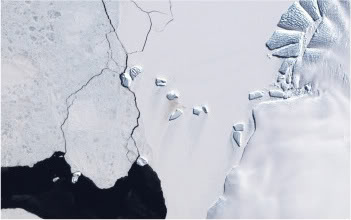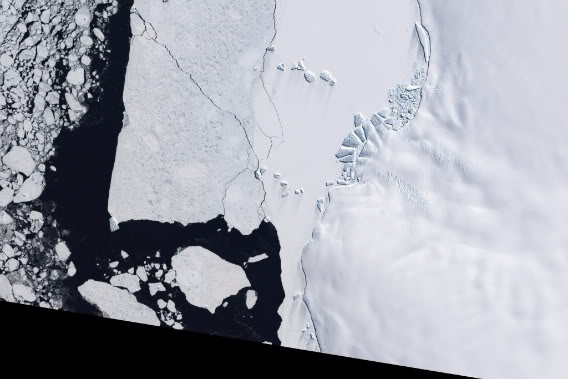|
|
Researchers from the British Antarctic Survey (BAS) have uncovered a novel way to locate the world’s largest penguin’s breeding sites, employing satellite imagery they seek out emperor penguin guano, droppings which show up starkly on the otherwise unsullied white sea ice of Antarctica.
Searching for the penguins themselves had proven too difficult, since the birds’ black-and-white coloring allowed them to blend in with the shadows made by the ice. The penguin droppings however are light-brown—a colors that has no other source on sea ice, besides guano.
 In the center of this image is a light-brown stain marking an emperor penguin colony. This detail of a true-color image was acquired by NASA’s Landsat 7 satellite on December 4, 2002. Photo courtesy of NASA. |
Emperor penguins Aptenodytes forsteri have a truly unique natural history. Unlike other penguins that breed on land, emperor penguins breed on sea ice in the dead of the Antarctic winter. This behavior may make them vulnerable to future climate change: earlier spring thaws caused by warming could leave penguin chicks stranded on sea ice.
Scientists have been trying to get an accurate count of the emperor penguin population to predict how vulnerable the birds may be to climate change, and the guano seen from space may be the key. The BAS team were able to identify 38 emperor penguin colonies from guano markings; this is four more than previous studies have found. Sixteen of the colonies are north of 70 degrees south, which could put them in the danger zone if spring melt begins occurring earlier, as is expected.
The BAS researchers caution, however, that more work needs to be done to determine how vulnerable this magnificent species will be to future warming.

The satellite image, with the guano-marked ice at center, is roughly 77.3 degrees south and 33.7 degrees west, falling on part of Antarctica’s Luitpold Coast due east of the Filchner Ice Shelf. Photo courtesy of NASA.
Related articles
Global warming may doom emperor penguins to extinction
(01/27/2009) Disappearing sea ice around Antarctica may put emperor penguins at risk of extinction within the next century, warn scientists writing in this week’s Proceedings of the National Academy of Sciences.
Studying world’s rarest penguin leads to the discovery of a new species
(11/19/2008) Researching one of the world’s most endangered penguins in New Zealand, the yellow-eyed penguin, has led to a remarkable discovery. DNA from 500-year-old penguin fossils has shown that the country was once home to not just one penguin species, but two. The DNA has resurrected an unknown extinct penguin, which researchers have named the Waitaha Penguin.
2-degree rise in temperature may doom penguins colonies
(10/10/2008) More than half Antarctica’s penguin colonies are at risk by a 2-degree global rise in temperatures, according to a report released by the environmental group WWF.